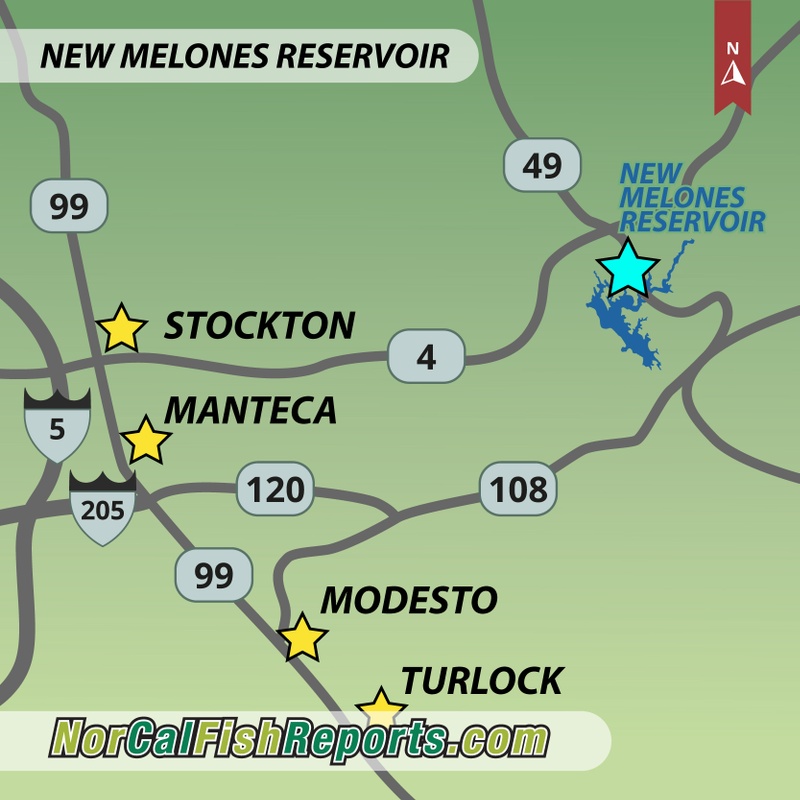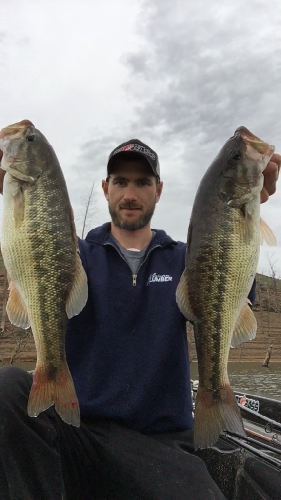Nor Cal Fish Report
New Melones Reservoir Fish Report for 1-25-2016
New Melones Reservoir Fish Report for 1-25-2016
Glory Hole Fishing Report
New Melones Reservoir - Angels Camp, CA

by Glory Hole Sports Staff
1-25-2016
(209) 736-4333
Website
Water Conditions: New Melones Lake is currently holding 369,519 acre-feet of water. The lake level came up seven feet this past week. It is currently at 827 ft. above sea level and 259 ft. from full. The water clarity is stained due to recent rainfall and wind. Some areas are clear and not affected by the storms. There is some debris floating on the surface. The water temperature remains cool, with the average being 49-52 degrees. The dam area is buoyed off due to current that is created when releasing water. Glory Hole Point boat launch is a two lane dirt and gravel road leading off of the end of the point. There is not a courtesy dock and it is best to launch with a 4-wheel drive vehicle.
Trout: Okay. The DFG has recently planted fish in New Melones. We have had a few more reports of anglers catching some trout. Most of the fish being caught are planters, with an occasional holdover being caught. The trout bite is much slower than we had anticipated, but we remain hopeful that some better fish will start to show up. With the rising lake level and the fresh water flowing into the lake, the trout should be closer to the shallow water making them easier to find and catch. Bank anglers have been catching a few fish off of Glory Hole Point and near the 49-bridge. Try using a crawler/mallow combo or floating a crawler with a Berkley Power Egg. Be sure to use a light wire hook to ensure your presentation remains floating. It is not a bad idea to bring an extra rod and fan cast a lure while your bait soaks. Try using a Kastmaster or a Krocodile to make long casts over deep water. Make sure you purchase a second rod stamp if you have two lines in the water. Boating anglers have been having some luck trolling over the main river channel up to Horseshoe Bend. Light trolling spoons and small minnow-like plugs have been the bait of choice. Also, try fishing bays, pockets and flats and casting your lures into shallow water. Look for the areas that have fewer trees. Once you have located an area that is holding fish, try pulling your boat to shore and fishing with a bait rig off the bottom to get some additional bites. Use a worm threader and a worm blower to float your crawler above the brush. The trout will be able to easily find it, if it is suspended in open water and not buried on the bottom. We do encourage catch and release for the brown trout as The Department of Fish and Game will no longer be planting them. Carefully measure, weigh and photograph trophy fish and send us pictures and information.
Kokanee: Done. Generally we will start seeing a few fish caught in April.
Bass: Good. There have been a handful of bass anglers that are fishing the lake on a weekly basis. Most are reporting a good bite with plenty of action throughout the day. It is January and the water temperature is cold. This will slow down their metabolism making them less willing to chase your presentation. There are a handful of ways to catch fish, but a bottom bouncing bait fished slowly is hard to beat. Try using a shakey head with your favorite soft plastic bait. Once your bait has reached the bottom, move it in small increments to ensure it stays in front of the fish long enough for them to commit. If you feel you bait is near prime structure, let it rest and shake it in place. This will coax the nearby fish into biting. Another good choice for fishing on the bottom is a jig. California Reservoir Lures makes a variety of jigs that are perfect for fishing any of the Mother Lode lakes. Browns and greens work well and purple has always been a go to color in cold water conditions. While dragging these bottom bouncing baits, keep a close eye on your electronics. Look for schools of bait and schools of active fish. Once you find them, you can use a vertical presentation to catch a bunch of fish. There are two vertical presentations one should always have tied on for wintertime fishing. The first is a dropshot rig. Choose a handful of different colors and sizes of soft plastic baits. Then rotate through them until you determine which ones the fish really want. Some areas a shad pattern will work best and other areas a darker color will excel. The second vertical presentation that is a must have, is a spoon. Often times a spoon will trigger bites that a dropshot won't. It also has drawing power. It will create vibration each time it flutters to the bottom and can be fished on the bottom to create a ticking sound. PLEASE PRACTICE CATCH AND RELEASE. The spawn is near and many fish will be holding eggs. Take photos and carefully release the fish back into to the lake to maintain a healthy fish population for generations to come.
Catfish: Okay. Some anglers have found a few catfish. Generally the fish will slow way down in the winter due to cold water temperatures. However, they are opportunistic feeders and will bite when a meal is near. Try using frozen fish or a large ball of nightcrawlers. Look for areas that have slightly warmer water. The catfish will be more active and more likely to feed in warm water.
Glory Hole Sports Big Fish of the Week goes to Ted Campbell of Sonora. He caught a massive catfish that weighed 12-pound, 1-ounce while soaking chicken liver in the Angels Creek Arm.
Crappie: Slow. The crappie bite will pick up once the water warms during the spring.
Trout: Okay. The DFG has recently planted fish in New Melones. We have had a few more reports of anglers catching some trout. Most of the fish being caught are planters, with an occasional holdover being caught. The trout bite is much slower than we had anticipated, but we remain hopeful that some better fish will start to show up. With the rising lake level and the fresh water flowing into the lake, the trout should be closer to the shallow water making them easier to find and catch. Bank anglers have been catching a few fish off of Glory Hole Point and near the 49-bridge. Try using a crawler/mallow combo or floating a crawler with a Berkley Power Egg. Be sure to use a light wire hook to ensure your presentation remains floating. It is not a bad idea to bring an extra rod and fan cast a lure while your bait soaks. Try using a Kastmaster or a Krocodile to make long casts over deep water. Make sure you purchase a second rod stamp if you have two lines in the water. Boating anglers have been having some luck trolling over the main river channel up to Horseshoe Bend. Light trolling spoons and small minnow-like plugs have been the bait of choice. Also, try fishing bays, pockets and flats and casting your lures into shallow water. Look for the areas that have fewer trees. Once you have located an area that is holding fish, try pulling your boat to shore and fishing with a bait rig off the bottom to get some additional bites. Use a worm threader and a worm blower to float your crawler above the brush. The trout will be able to easily find it, if it is suspended in open water and not buried on the bottom. We do encourage catch and release for the brown trout as The Department of Fish and Game will no longer be planting them. Carefully measure, weigh and photograph trophy fish and send us pictures and information.
Kokanee: Done. Generally we will start seeing a few fish caught in April.
Bass: Good. There have been a handful of bass anglers that are fishing the lake on a weekly basis. Most are reporting a good bite with plenty of action throughout the day. It is January and the water temperature is cold. This will slow down their metabolism making them less willing to chase your presentation. There are a handful of ways to catch fish, but a bottom bouncing bait fished slowly is hard to beat. Try using a shakey head with your favorite soft plastic bait. Once your bait has reached the bottom, move it in small increments to ensure it stays in front of the fish long enough for them to commit. If you feel you bait is near prime structure, let it rest and shake it in place. This will coax the nearby fish into biting. Another good choice for fishing on the bottom is a jig. California Reservoir Lures makes a variety of jigs that are perfect for fishing any of the Mother Lode lakes. Browns and greens work well and purple has always been a go to color in cold water conditions. While dragging these bottom bouncing baits, keep a close eye on your electronics. Look for schools of bait and schools of active fish. Once you find them, you can use a vertical presentation to catch a bunch of fish. There are two vertical presentations one should always have tied on for wintertime fishing. The first is a dropshot rig. Choose a handful of different colors and sizes of soft plastic baits. Then rotate through them until you determine which ones the fish really want. Some areas a shad pattern will work best and other areas a darker color will excel. The second vertical presentation that is a must have, is a spoon. Often times a spoon will trigger bites that a dropshot won't. It also has drawing power. It will create vibration each time it flutters to the bottom and can be fished on the bottom to create a ticking sound. PLEASE PRACTICE CATCH AND RELEASE. The spawn is near and many fish will be holding eggs. Take photos and carefully release the fish back into to the lake to maintain a healthy fish population for generations to come.
Catfish: Okay. Some anglers have found a few catfish. Generally the fish will slow way down in the winter due to cold water temperatures. However, they are opportunistic feeders and will bite when a meal is near. Try using frozen fish or a large ball of nightcrawlers. Look for areas that have slightly warmer water. The catfish will be more active and more likely to feed in warm water.
Glory Hole Sports Big Fish of the Week goes to Ted Campbell of Sonora. He caught a massive catfish that weighed 12-pound, 1-ounce while soaking chicken liver in the Angels Creek Arm.
Crappie: Slow. The crappie bite will pick up once the water warms during the spring.
< Previous Report Next Report >
< Previous Report Next Report >
More Reports
New Melones Reservoir Report
New Melones ReservoirWater Conditions: New Melones Lake is currently holding 343,607 acre-feet of water. The lake level came up over three feet this past week. It is currently at 820 ft. above sea level and 266 ft. from full. The water clarity is stained due to recent rainfall and wind. Some areas are clear and not affected by the storms. There is some debris floating on the surface. The water temperature remains cool, with the average...... Read More
New Melones Reservoir Report
New Melones Reservoir
1-17-2016
Took a trip to Melones on 1/17, overall The bite is good. The water has risen close to twenty feet...... Read More

www.NorCalFishReports.com © 2024. All Rights Reserved.
Website Hosting and Design provided by TECK.net
Website Hosting and Design provided by TECK.net